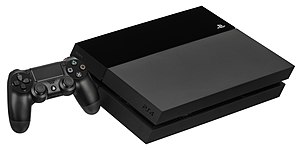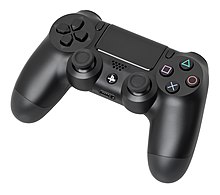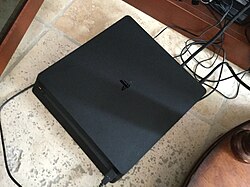DIFFERENCE BETWEEN PS4 SLIM AND PRO

Sony launched two new PS4 consoles back in 2016. The PS4 Pro represents a meatier, more powerful unit that delivers better performance capable of 4K gaming and HDR.
It’s other new console became known as the PS4 Slim, which offers the same functionality as the launch model in a sleeker form factor. Sony calls this the ‘PS4’ as it’s phased out the original console.
That’s the basics, but in our PS4 Pro vs PS4 guide will explain the details in simple terms –
PS4 Pro vs PS4 – Dimensions
The graphics processor (GPU) in the PS4 Pro – that’s the bit that generates the 3D graphics in games – is just over twice as powerful as that in the PS4. Sony’s also upgraded the processor, which handles things like physics and artificial intelligence in games.
Sony claims the new PS4 Pro can run at 4.2 teraflops, compared to the 1.84 teraflops of the original PS4 – teraflops is a simple measure of computer performance, a bit like horsepower in cars. We’ll get onto how that power is used a little later.
In addition, while the PS4 Pro has the same amount of memory as the original PS4 – 8GB GDDR5 – it runs at a higher speed to improve performance. The PS4 Pro also has an extra 1GB of memory for non-gaming applications like Netflix. This means they won’t waste space games can use and means you can switch between apps faster
PS4 Pro vs PS4 Graphics Comparison
It depends on the game. Developers can use the extra power for anything they want within reason. Most will increase the resolution – the number of pixels that make the picture – of their games, so they appear sharper on 4K TVs, but that’s not all.
Developers can also use the more powerful PS4 Pro GPU to improve the quality of textures and lighting effects, leading to more realistic graphics and smoother performance with fewer slowdowns. The only demand Sony makes is games must play as well on the PS4 Pro as they do on the PS4, and vice versa.
But beware watching YouTube videos that compare the two. Unless you’re viewing videos in 4K on a 4K TV, it’s really hard to tell the difference. In this case, still images are often the best comparison. Look closely at the examples below:
Here’s a shot of a demo running on the PS4.
And now the same demo running on the PS4 Pro.
The most obvious difference is the lighting. The ‘god rays’ give the scene a new dynamism, lighting up the rocks and enhancing the contrast in the scene.
Another benefit is the foliage. There’s copious extra greenery, such as extra plants, grass and vines. The PS4 version has simpler, flatter textures that add little.
The PS4 Pro isn’t just about making things look sharper. More power allows developers to render more items in the game, which helps create worlds that are packed with more interesting details to enjoy.
PS4 Pro vs PS4 – Games
There’s no such thing as a ‘PS4 Pro Exclusive’ game. Games must be enhanced for PS4 Pro, but Sony won’t allow any game to only run on PS4 Pro.
All PS4 games must now support a PS4 Pro mode with improved graphics and performance, but some games do this better than others.
Horizon Zero Dawn: This is the first PS4 exclusive designed specifically with the PS4 Pro in mind. It looks stunning, so it’s must-have for any PS4 Pro owner.
Resident Evil 7: An excellent game that really benefits from HDR, adding to the already creepy feeling throughout the game.
Rise of the Tomb Raider: One of the best examples of PS4 Pro upgrades. While it doesn’t support HDR, visual improvements in both ‘4K’ and 1080p make this is a visual treat.
The Last Guardian: Supports both 4K and 1080p high performance modes on PS4 Pro and the HDR. HDR works on the existing PS4 as well, however.
The Last of Us Remastered: Probably the best game for HDR in the PS4 Pro line-up, it supports native 4K at 60fps and looks great.
Hitman: No HDR support, but both performance and textures are improved on PS4 Pro.
Battlefield 1: One of the best PS4 Pro upgrades around. There’s more terrain detail and you’ll even get a performance advantage in busy multiplayer games.
Watch Dogs 2: Looks great in the 4K and 1080p supersampled versions thanks to improved anti-aliasing
The Witcher 3: Wild Hunt: CD Projekt Red recently updated its epic RPG to fully support HDR and 4K upscaling and, as predicted, it looks pretty stunning.
How much larger is the PS4 Pro compared to the PS4?
Quite a bit, which is worth considering if space is an issue, though the PS4 Pro’s still smaller than the notoriously huge original Xbox One.
PS4 Pro vs PS4 Size Comparison(WxDxH):
PS4 Pro vs PS4 Size Comparison(WxDxH):
- New PS4 Slim: 26.5 x 28.8 x 3.9cm
- Original PS4: 27.5 x 30.5 x 5.3cm
- PS4 Pro: 29.5 x 32.7 x 5.5cm
So the PS4 Pro is a good three centimetres wider, four centimetres deeper and close to two centimetres taller. That doesn’t sound like much written down, but the PS4 Pro is actually 78% larger in volume than the PS4 ‘Slim’ model – it’s 20% larger than the launch console.
Here are the PS4 Pro specs compared to the original and PS4 ‘Slim’ versions:
| PS4 (2013) | PS4 (2016) | PS4 Pro | |
|---|---|---|---|
| CPU | 1.6GHz 8-core AMD Jaguar | 1.6GHz 8-core AMD Jaguar | 2.1GHz 8-core AMD Jaguar |
| GPU | 1.84 TFLOP AMD Radeon | 1.84 TFLOP AMD Radeon | 4.2 TFLOP AMD Radeon |
| Memory | 8GB GDDR5 | 8GB GDDR5 | 8GB GDDR5 & 1GB |
| HDR | Yes | Yes | Yes |
| 4K | No | No | Yes |
| Storage | 500GB | 500GB & 1TB | 1TB |
| USB | 2x USB 3.0 | 2x USB 3.1 | 3x USB 3.1 |
| Wi-Fi | 802.11b/g/n Wi-Fi (2.4GHz only) | 802.11a/b/g/n/ac Wi-Fi (2.4GHz & 5.0GHz) | 802.11a/b/g/n/ac Wi-Fi (2.4GHz & 5.0GHz) |
| Bluetooth | Bluetooth 2.1 | Bluetooth 4.0 | Bluetooh 4.0 |








